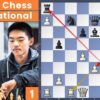In the heart of Arlington, Texas, a seismic shift in the world of competitive chess is unfolding. The “Checkmate: USA v. India” event, hosted within the modern confines of Esports Stadium Arlington, isn`t just another tournament; it`s a meticulously crafted spectacle. It`s where the titans of American chess lock horns with India`s prodigious new guard, all while the digital spotlight of global streaming audiences illuminates every move. This isn`t merely a game of intellect; it`s a strategic showcase, a cultural crossroads, and a clear signal of chess`s vibrant, evolving future.
A Clash of Generations and Global Dominance
The lineup itself reads like a dream match for any chess enthusiast. From the American side, we witness the strategic prowess of legends like Hikaru Nakamura and Fabiano Caruana—names synonymous with world-class chess. Their challengers from India represent a powerful new wave: the formidable Gukesh Dommaraju and the highly talented Arjun Erigaisi, both rapidly ascending the global rankings. It`s a classic encounter: established might against surging ambition. This narrative extends beyond the top boards, featuring rising women players like Carissa Yip (USA) and Divya Deshmukh (India), and prodigious youth talents such as Tanitoluwa Adewumi (USA) and Ethan Vaz (India).
But this event also smartly acknowledges the modern landscape of chess. The inclusion of beloved streamers like the USA`s Levy Rozman and India`s Sagar Shah, whose combined reach extends to over ten million followers, underscores a fascinating truth: chess is no longer confined to quiet halls. It thrives where the audience is, transforming from a silent battle of wits into an interactive, global phenomenon that draws millions.
The Format: A Test of Nerve and Speed
Beyond the star power, the event`s format injects a potent dose of adrenaline into every game. Each of the five pairings between USA and India is contested under a rapid time control: 10 minutes per player, with a one-second increment. This ensures swift, decisive action, leaving little room for protracted thought or cautious maneuvering. It’s a format designed for high-octane chess, where intuition often trumps endless calculation.
Perhaps the most intriguing rule, however, is the “no resignations” clause. Games *must* be played to checkmate, stalemate, or flag. While traditionalists might raise an eyebrow at this perceived deviation from gentlemanly surrender, it guarantees every game concludes with maximum drama – ensuring no early concessions and pushing players to fight for every half-point, even in seemingly lost positions. One might even suggest it’s a subtle nod to the esports ethos: victory must be absolute, defeat undeniable.
Should a game end in a draw, the intensity ratchets up further, moving through a series of tie-breaks:
- A five-minute overtime game
- A one-minute shootout
- Additional one-minute games until a winner is determined
This setup promises edge-of-the-seat entertainment, making every round a miniature epic and ensuring that every contest culminates in a clear victor.
The Stakes and the Spectacle
This `Checkmate` event is more than just a series of matches; it`s a bellwether for the future of competitive chess. It showcases how a game steeped in centuries of tradition can seamlessly integrate with the fast-paced, high-tech world of esports. For both the United States and India, national pride is undoubtedly on the line. India`s recent surge in chess talent has been remarkable, challenging the long-established dominance of traditional powerhouses. The USA, with its deep pool of top players, is eager to reaffirm its position.
The outcome of these clashes, featuring brilliant strategies and swift decisions, will resonate far beyond the confines of the Esports Stadium. It’s a compelling narrative of rivalry, innovation, and the enduring allure of the 64 squares, proving that chess, in its modern iteration, is as vibrant and captivating as ever. It is a testament to the game`s universal appeal and its remarkable adaptability in the digital age.








